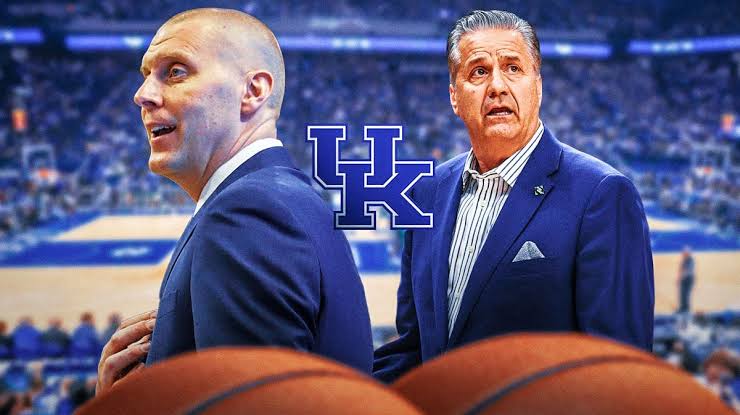When John Calipari, the longtime head coach of the Kentucky Wildcats, first encountered the NCAA’s transfer portal rule, he didn’t mince words. Calipari was vocal about his disapproval, calling it a disruptive force in college basketball. He viewed it as a challenge to the established system, where recruiting was paramount, and stability within programs was seen as crucial for long-term success. However, just a few years later, it’s become clear that this rule, once loathed by Calipari, is now serving as a vital tool for Mark Pope, who has inherited the monumental task of rebuilding Kentucky’s roster after the Wildcats’ season-opening win.
What Changed for Calipari, and Why Is Pope Thriving with the New Rule?
The NCAA’s transfer portal, introduced in 2018 and formally expanded in 2021, allowed college athletes to transfer between schools without having to sit out a season. For many, this rule signaled a shift in the power dynamics of college basketball, as players were granted more agency over their careers. It also created a fluid environment for roster changes, where teams could acquire experienced players in an instant, but that didn’t sit well with Calipari, who traditionally built his programs through high school recruiting.
Despite his initial resistance, Calipari eventually embraced the new reality of roster construction in college hoops. He recruited players with the understanding that they could leave after one season and needed to be replaced quickly through the portal. But even then, Calipari’s focus remained on bringing in high-level recruits, often prioritizing elite high school talent over transfers.
In contrast, Mark Pope, who took over the Kentucky program amid tumultuous years, recognized early on that the transfer portal could be a game-changer in stabilizing the Wildcats’ roster. As he looks to rebuild Kentucky’s basketball program, Pope has leaned heavily on the portal to add proven talent, shore up weak spots, and bring in players who can contribute immediately.
How the Transfer Portal Is Helping Pope’s Efforts
Pope’s strategy has been methodical, bringing in a mix of experienced players to complement the Wildcats’ young talent. For example, Pope added players with multiple years of collegiate experience—veterans who can bring leadership and immediate production to a team still figuring out its identity. Unlike Calipari’s reliance on a revolving door of one-and-done talent, Pope has used the portal to create a more balanced roster.
Pope’s success in using the transfer portal came to light during Kentucky’s season-opening win, which saw the Wildcats display cohesion and depth, thanks in part to the contributions from transfer players. These athletes have helped fill immediate gaps, particularly in areas such as leadership, shooting, and defense, giving Pope the tools he needs to steer the program forward.
The Key to Success: Blending Transfers with High School Recruits
While Pope has capitalized on the transfer portal, he has also maintained an emphasis on high school recruiting, ensuring that Kentucky remains a powerhouse in attracting top-tier young talent. The balance between developing high school recruits and utilizing the portal has been critical in the rebuilding process. Pope’s ability to blend the two recruiting avenues has set Kentucky apart as one of the more dynamic teams in college basketball.
In the Wildcats’ season opener, Pope’s mix of transfers and blue-chip recruits was on full display. The team showed a level of maturity and unity that had eluded Calipari’s Kentucky teams in recent years, in part because the roster was built with both short- and long-term goals in mind. Transfer players, like seasoned veterans, helped settle early nerves, while the incoming freshmen brought the kind of energy and upside that Kentucky fans expect.
The Bigger Picture: Why the Portal Is Here to Stay
Though it was initially met with resistance, the transfer portal is an undeniable force shaping the future of college basketball. For coaches like Mark Pope, it’s an essential tool to build and maintain competitive teams year in and year out. With the right balance of incoming transfers and traditional recruiting, teams can stay competitive regardless of how the roster may change from season to season.
John Calipari, for all his earlier objections, has also come to see the advantages of the portal, using it to supplement his program when necessary. But it’s Pope, with his sharp focus on roster management and blending experienced players with youthful energy, who seems to be turning this NCAA rule into an asset in rebuilding Kentucky basketball.
As Pope continues to harness the transfer portal to his advantage, the future of Kentucky Wildcats basketball looks brighter. After their impressive opening win, there is renewed hope among the fans that the program is on the right track. The lessons learned from the portal era may yet be the key to returning Kentucky to the top of the college basketball world, a place where it has historically thrived but where it’s been absent in recent years.
In a sport that evolves rapidly, Mark Pope’s use of the transfer portal could be the secret weapon Kentucky needed to get back to its winning ways.


